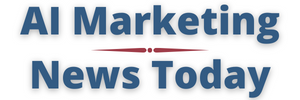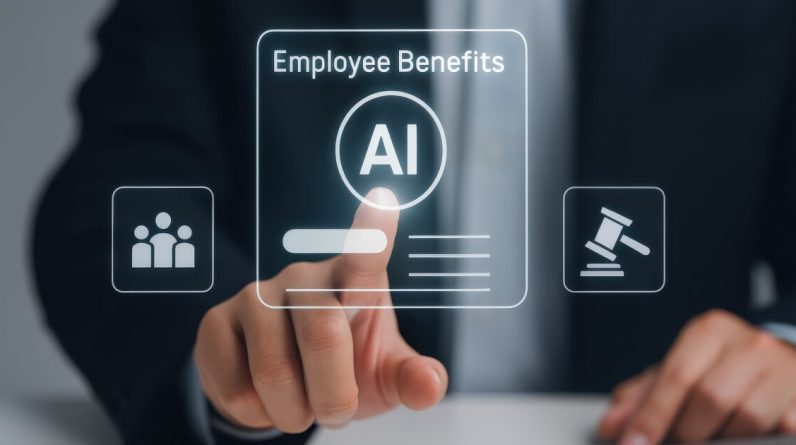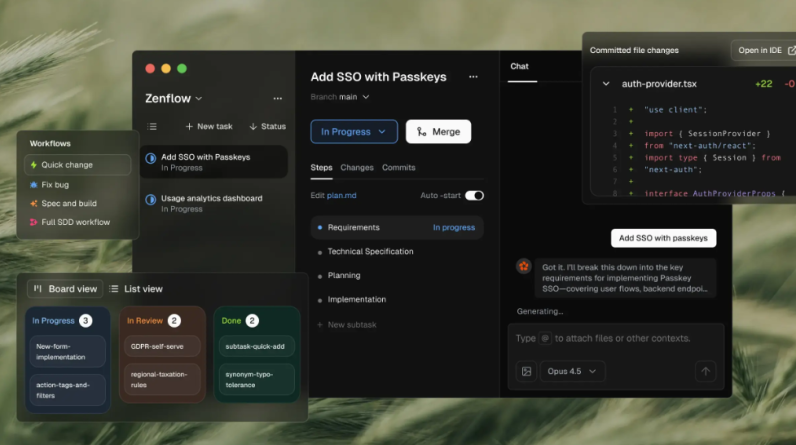Concept of HR recruitment showing digital human figures illustrated over a businessperson using a laptop. – CL STOCK // Shutterstock
What’s the right amount of AI when hiring?
Artificial intelligence is reshaping the way companies attract, assess, and hire talent, from crafting job postings to coordinating interviews and reviewing candidates. Job seekers are also turning to AI tools to simplify their search and make stronger impressions on employers.
Although AI offers valuable advantages for both organizations and applicants, preserving genuine human connection remains essential to making effective hiring decisions and building successful professional relationships.
Upwork, an online marketplace for hiring skilled freelancers, highlights the specific ways in which employers and candidates use AI in hiring, key benefits and drawbacks of doing so, and how to strike the right balance between AI and human insight.
The state of AI use in hiring
From automating job descriptions to refining resumes, artificial intelligence is reshaping how both hiring managers and job seekers approach the hiring and job search process. AI is being used at nearly every stage of the process — shifting expectations, workflows, and the overall experience.
How employers use AI to streamline recruitment
Employers embed AI into early and mid-stages of the hiring process. Candidate screening tasks that were once manual and time-consuming are now often automated by AI tools. This approach enables hiring managers to save time and focus on the most qualified applicants, as well as other critical business priorities.
An October 2024 survey of 1,005 U.S.-based hiring managers commissioned by Insight Global found that 99% of those surveyed reported using AI in some capacity in the hiring process. Additionally, 98% reported significant improvements in hiring efficiency using AI.
Common AI use cases during the hiring and recruitment process include:
-
Job description generation. Tools generate targeted, skills-based descriptions tailored to specific roles and business needs.
-
Resume parsing filtering. AI scans large applicant pools, ranking candidates by qualifications and keywords.
-
Simplifying interview logistics. Automated scheduling and reminders free up time for recruiters to focus on candidate engagement.
-
Candidate scoring. AI-powered platforms apply machine learning models to assess and rank applicants based on skills and experience.
How candidates use AI during the job search
Job seekers are also turning to AI to enhance their applications and improve their chances of moving forward with the hiring process.
Express Employment Professionals and Harris Poll surveyed over 1,000 U.S. adults about their job search habits in late 2024. More than three-quarters (78%) of respondents said they believe it’s appropriate to use AI for tasks such as drafting resumes and cover letters. However, 84% indicated they would prefer to have a person review their submitted application rather than AI alone. These findings highlight the gap between tool adoption and comfort with fully automated decision‑making.
Ways in which candidates use AI during the hiring process include:
-
Resume optimization. Generate tailored versions of resumes based on job descriptions and requirements.
-
Cover letter drafting. Quickly produce cover letter drafts that align with specific job expectations, then edit for tone, accuracy, and specificity.
-
Interview practice. Use AI tools to simulate recruiter questions and refine responses.
-
Keyword targeting. Ensure applications are aligned with applicant tracking system algorithm-friendly language.
Potential drawbacks of overreliance on AI in hiring
While AI offers clear efficiency gains, an overreliance on automated tools can introduce unintended consequences, both for organizations and candidates. From diluting authenticity in applications to undermining trust in the process, the risks aren’t always immediately visible but can have lasting effects.
Understanding these drawbacks is a key to building a balanced, effective hiring strategy that uses AI for support, but keeps people at the center of decision-making while maintaining connections.
1. Efficiency gains can undermine authenticity
When candidates use AI tools to generate application materials, their voice, intent, and individuality may get lost in the process. A resume or cover letter built entirely by an algorithm may be technically sound — but also generic and impersonal. This can make it harder for hiring managers to evaluate a candidate’s real strengths or cultural fit.
An early 2025 survey of 1,000 U.S.-based hiring managers distributed by Resume Genius found that nearly three-quarters (74%) of respondents have seen AI-generated content in resumes. Additionally, more than one-third have come across AI-generated portfolio samples. AI-generated applications can mask candidates’ true skills and experience, which can lead to organizations hiring individuals who aren’t qualified for the job.
The solution isn’t to ban AI or discourage AI use during the job search. However, thoughtfully reviewing job applications and proposals to understand a candidate’s skills, experience, goals, and potential can help identify the most qualified individuals.
2. Impersonal processes can erode candidate trust
The hiring process is two-sided; candidates are evaluating companies just as much as employers are evaluating job seekers. When hiring relies too heavily on automation — especially without clear communication — candidates may perceive the experience as cold, transactional, or even biased.
A ServiceNow survey of 1,008 U.S. residents in December 2024 found that over 65% of respondents feel uncomfortable with AI being used in hiring, and nearly 90% want transparency about how and when employers apply AI. Top concerns include a lack of personalization, limited clarity on decision-making, and risks to data privacy.
These findings align with a well-established concept in industrial-organizational psychology — applicant reactions. When job seekers view a hiring process as overly impersonal, unpredictable, or opaque, they’re less likely to accept an offer — and more likely to form negative opinions about the organization, which can have a lasting impact on a company’s employer brand.
Designing for fairness, transparency, and human interaction can offer hiring teams a strategic advantage by positively impacting acceptance rates, referrals, and long-term engagement.
3. AI alone can’t assess soft skills or team fit
AI-powered algorithms are effective at processing patterns and summarizing credentials, but often fall short when it comes to evaluating interpersonal qualities, emotional intelligence, and team dynamics. Soft skills like empathy, adaptability, and communication style require human observation and context.
Most hiring professionals recognize this. The Express Employment Professionals survey found that 89% of hiring managers indicated human input is essential for evaluating soft skills. In addition, 68% said the risks of AI outweigh the benefits if people are removed entirely from the process. On the job seeker side, 87% of respondents agree that meeting with a human during interviews is important, as AI cannot effectively vet candidates for soft skills such as cultural fit and attitude.
AI tools also introduce the potential of algorithmic bias. Without proper oversight, AI systems can reinforce inequalities by replicating patterns from historical data. If this data reflects past hiring inequities, the system may unintentionally exclude qualified candidates or perpetuate existing gaps.
When it comes to evaluating soft skills and making final hiring decisions, AI should support, rather than replace, human judgment. Hiring teams are uniquely equipped to ask deeper questions, read nuance, and consider how a candidate may grow or adapt within a team or organization. Combining these insights with the efficiency of initial AI screening is where the real value lies.
A blended approach to hiring: Balancing AI and human input
Rather than viewing AI as a replacement for human connection, a more constructive mindset is to see AI as a support tool. A key goal of using AI should be to automate routine, time‑consuming tasks so hiring teams and job seekers can focus on the higher‑value work of connection and relationship-building.
Practical tips for organizations
Implementing a balanced hiring process requires thoughtful consideration. By identifying ways to improve your hiring efforts over time and balancing automation with human judgment, you can support a positive candidate experience and make more effective hiring decisions.
Here are some tips to consider:
-
Map your workflow. Identify which steps in your process would benefit most from automation (such as job post drafting, initial screening, and interview scheduling), as well as which tasks should remain human‑led (like final interviews, fit assessments, and the offer stage).
-
Evaluate all AI tools. Select tools that have been developed and trained with ethical standards and bias prevention in mind to support a fair process. Also evaluate which privacy and security measures are in place to protect candidates’ personal data and minimize potential fraud.
-
Design human touchpoints intentionally. Introduce interview segments that offer candidates opportunities to ask open questions, share their motivations, and meet a potential future team member. Consider video intros, informal chats, and peer interviews to learn more about candidates beyond their application or proposal.
-
Be transparent. Let candidates know where AI is being used, how decisions are made, and which steps human members of your team will review. Transparency builds trust.
-
Monitor and gather feedback. Track candidate satisfaction, drop‑off rates, offer acceptance percentage, and employer brand perception. When you introduce new AI tools and other technology, treat them as experiments and evaluate effectiveness over time.
-
Train your teams. Equip recruiters and hiring managers with training to understand the strengths and limits of AI. Encourage critical thinking so team members know when to use their own expertise and insight over AI-powered recommendations.
Advice for job seekers
As a candidate in today’s AI-driven job market, bringing authenticity to each step of the process can help you make a positive impression and build stronger connections with prospective employers or clients. While AI may help you get started, the way you show up and display your ideas, voice, and experience can make a lasting impression.
Here are a few ways to engage more intentionally in an AI-supported environment:
-
Use AI to start, then personalize. Let a tool help you structure your resume or draft a cover letter, then refine the initial output using your voice. Show what makes you unique and motivated for the specific job. Also avoid embellishing your skills and experience, because you want to make sure your qualifications align with the job.
-
Highlight thinking over inserting keywords. As much as algorithms scan for keywords, humans assess clarity, motivation, and authenticity. Beyond incorporating keywords, let your application tell your story.
-
Prepare to build human connection. The interview stage is one of the most important steps in the hiring process. Even if your application materials are AI‑assisted, potential future teams want to meet you. Be ready to engage, ask questions, and assess whether the employer is a good fit for you.
-
Ask about how AI is used. If you face multiple automated steps, consider how decisions are made, who reviews your materials, and how you’ll receive feedback.
Efficient, AI-powered hiring and human connection aren’t mutually exclusive. With the right mindset and approach, technology can amplify both hiring team and candidate strengths.
This story was produced by Upwork and reviewed and distributed by Stacker.






